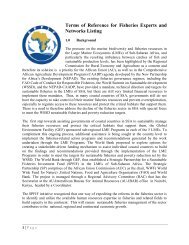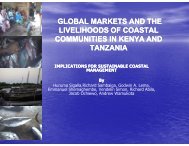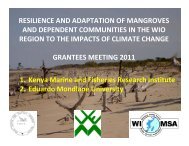Managing Marine Protected Areas Managing Marine Protected Areas
Managing Marine Protected Areas Managing Marine Protected Areas
Managing Marine Protected Areas Managing Marine Protected Areas
You also want an ePaper? Increase the reach of your titles
YUMPU automatically turns print PDFs into web optimized ePapers that Google loves.
Some MPAs may be the responsibility primarily or entirely<br />
of local communities with no local or national government<br />
support. Such protected areas are, however, often difficult<br />
to maintain, although community-level local by-laws can<br />
partially help to provide legal backing.<br />
In some cases, the private sector is responsible for<br />
management. On Zanzibar, the management of Chumbe<br />
Reef Sanctuary is delegated to a private company<br />
(Chumbe Island Coral Park Ltd., see organogram below).<br />
An agreement has been drawn up between the<br />
government and the company specifying the role of the<br />
company and a representative Advisory Committee has<br />
been established. In Mozambique, Inhaca Faunal Reserve is<br />
managed by the Universidade Eduardo Mondlane, having<br />
been set up through the <strong>Marine</strong> Biological Station. Such<br />
delegated organisations are generally responsible for<br />
personnel, revenue collection, day-to-day management,<br />
environmental education and visitor management.<br />
COMMITTEES AND BOARDS<br />
Many or most MPAs have a Board of Directors or Advisory<br />
Committee to assist with decision making, and this<br />
sometimes has executive powers. These bodies should<br />
represent key stakeholder groups, including local<br />
communities, scientists and academic institutions, the<br />
private sector and the various government agencies<br />
involved. Such boards and committees should be<br />
established as early on in the planning process as possible,<br />
and certainly at the beginning of development of the<br />
management plan. Members are usually appointed by the<br />
MPA administration or by a government authority such as<br />
a Minister, and their role, functions and procedures should<br />
be clearly defined in TORs or even in law. Depending on<br />
their legal or other structure, these bodies can have<br />
important roles in consultation, evaluation, reviewing<br />
progress and approving management plans, and<br />
authorising budgets and other specific expenditures. They<br />
should interact regularly, and it is often the responsibility<br />
of the MPA to organise and convene meetings. Many<br />
meetings and interactions demand participatory and<br />
conflict resolution skills since they may involve divergent<br />
parties and viewpoints.<br />
Many MPAs also have other committees for specific<br />
purposes. Village level advisory committees are very<br />
important in some MPAs, where communities play an<br />
important role in decision-making, as in some of the<br />
Tanzanian <strong>Marine</strong> Parks. For example, in Mnazi Bay-<br />
Resource Protection<br />
Coordinator and Rangers<br />
Advisory Committee<br />
Village, government and<br />
university representatives<br />
CHICOP Ltd.<br />
Visitor Experience<br />
and Enjoyment<br />
Education and tourism staff<br />
Ruvuma Estuary <strong>Marine</strong> Park, Village Environmental<br />
Committees play a key role. In other MPAs there may be<br />
committees and task forces for specific activities, such as<br />
the Scientific Committee for Aldabra Special Reserve and<br />
World Heritage Site. Where possible, it is advisable to use<br />
existing bodies of this kind, rather than establishing new<br />
committees that will take up time and may risk duplicating<br />
the activities of others.<br />
ENFORCEMENT<br />
The management structure may affect how enforcement<br />
and compliance activities are undertaken. Sometimes<br />
enforcement is carried out by MPA personnel, but other<br />
government personnel with ‘powers of arrest’ may have to<br />
be co-opted to arrest offenders. Links with the judiciary<br />
(e.g. police, magistrates), as well as government planning<br />
bodies and research institutes are important and should<br />
feature on the full organisational chart. Where appropriate,<br />
TOR should be drawn up describing their role in<br />
MPA management and relationship to other stakeholders.<br />
KEY POINTS FOR THE MPA<br />
❑ Be fully conversant with the organisational structure<br />
including policy and legal instruments.<br />
❑ Interact regularly with all bodies and ensure that<br />
formal meetings are organised on a regular basis or<br />
as provided for in the MPA statutes and legislation,<br />
and develop skills for effectively managing these.<br />
❑ Ensure speedy follow-up on decisions made at such<br />
meetings, circulate minutes promptly and promote<br />
continuous dialogue on a day-to-day basis.<br />
❑ Build networks with other relevant agencies such as<br />
land use or physical planning.<br />
Sources of further information<br />
Borrini-Feyerabend, G. 1996. Collaborative Management of<br />
<strong>Protected</strong> <strong>Areas</strong>: Tailoring the Approach to the Context. Issues in<br />
Social Policy, IUCN, Gland, Switzerland. 67pp.<br />
Pomeroy, R.S., Parks, J.E. & Watson, L.M. 2004. How is your MPA<br />
doing? A Guidebook of Natural and Social Indicators for Evaluating<br />
<strong>Marine</strong> <strong>Protected</strong> Area Management Effectiveness. IUCN, Gland,<br />
Switzerland and Cambridge, UK. 230pp.<br />
Salm, R.V., Clark, J.R. & Siirila, E. 2000. <strong>Marine</strong> and Coastal<br />
<strong>Protected</strong> <strong>Areas</strong>: A Guide for Planners and Managers. 3rd Edition.<br />
IUCN, Washington, D.C., USA.<br />
Facilities, Operations<br />
and Maintenance<br />
Ecolodge manager and<br />
support staff<br />
Chumbe Island Organogram<br />
Administration<br />
Administration staff<br />
Sheet A3 <strong>Managing</strong> <strong>Marine</strong> <strong>Protected</strong> <strong>Areas</strong>: A TOOLKIT for the Western Indian Ocean






